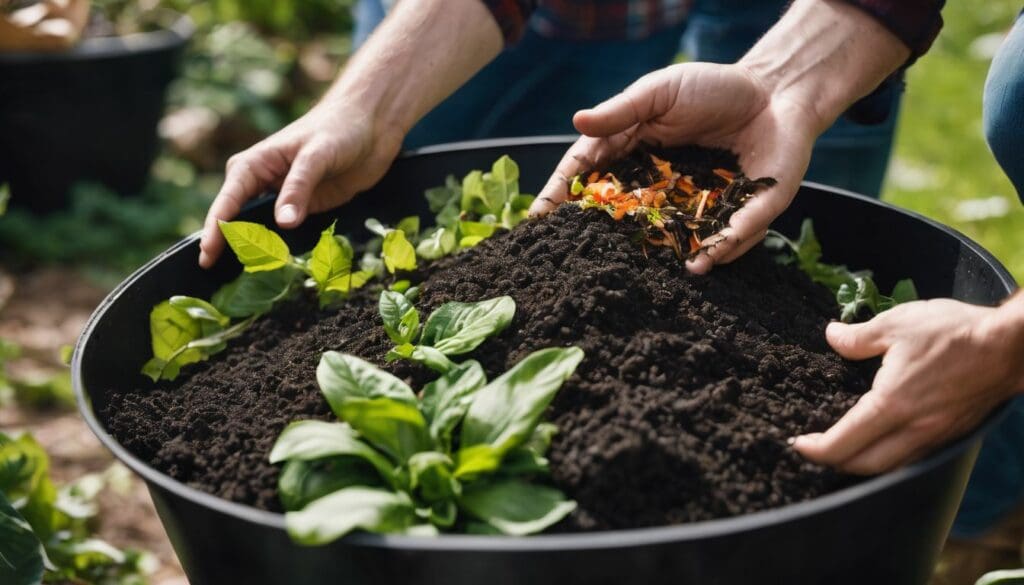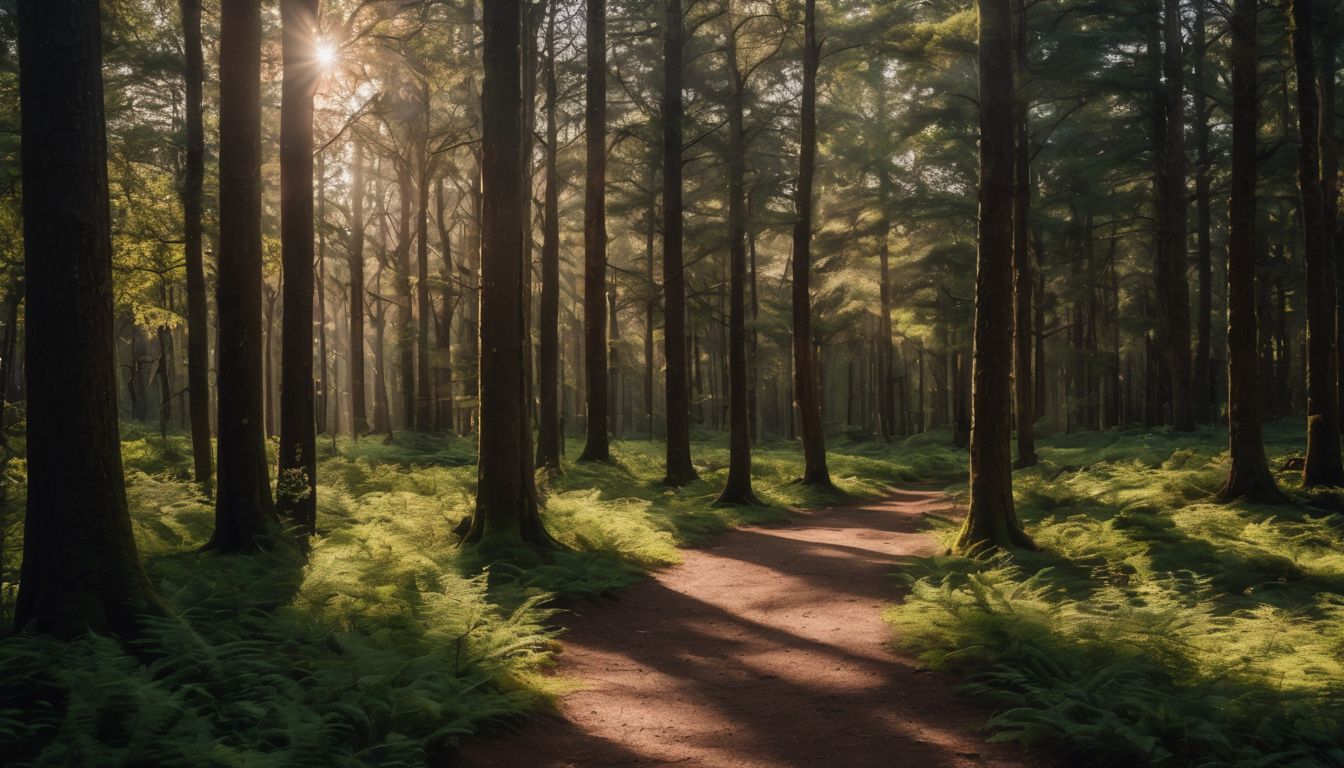Do you ever catch yourself glancing at those kitchen scraps, a pang of guilt washing over you for simply tossing them away? You’re not alone in that sentiment. It’s quite the eye-opener to realise that a whopping 28% of what we chuck into our bins could be given a second life through composting.
Fear not! Our comprehensive guide is here to demystify this process and show you how these leftovers can become a veritable goldmine for your garden soil. Ready to unearth the secrets of savvy waste transformation? Then let’s embark on this composting adventure together!
Key Takeaways
- Composting turns kitchen scraps and yard waste into valuable soil, with around 28% of our rubbish being transformable into compost.
- Different methods exist for composting, such as traditional, vermicomposting, bokashi, and more; each suits different lifestyles and space availabilities.
- To create healthy compost: balance green (nitrogen-rich) materials like fruit peels with brown (carbon-rich) materials like dry leaves; keep the pile moist but not wet; turn regularly to aid decomposition.
- Not everything can be composted. Avoid adding meat, dairy products, diseased plants, pet waste or oily foods to prevent pests and diseases in your pile.
- Finished compost is dark and crumbly and has lots of uses in the garden: add it to planting holes or beds to enrich soil or use as a mulch to retain moisture and suppress weeds.
The Art of Composting: A Magical Process
Composting is a magical process that transforms kitchen scraps and yard waste into nutrient-rich soil, benefiting both the environment and your garden. There are different methods for composting, and choosing the right compost bin is important for successful decomposition.
Benefits of composting
We all know the importance of keeping our gaming environments clean and clutter-free for optimal performance. In a similar way, composting plays a crucial role in tidying up our planet by reducing waste.
By turning everyday kitchen scraps into nutrient-rich soil, we’re not only managing organic waste efficiently but also enriching our gardens – it’s like upgrading to the best gear for your plants.
Food waste that could otherwise contribute to landfill problems now becomes part of an eco-friendly cycle.
Our love for efficiency in gameplay translates well into the art of composting; it’s both easy and cost-effective. We mix different biodegradable materials to create homemade garden fertiliser that helps plants grow stronger and healthier – a natural power-up! Composting directly supports environmental sustainability by cutting down on methane emissions from landfills which are significantly reduced when organic matter is recycled at home instead.
So let’s roll up our sleeves, recycle those food scraps, yard trimmings, and embark on this adventure towards sustainable gardening magic together!
Different composting methods
Now that we understand the benefits of composting, let’s explore different composting methods. There are several effective ways to turn kitchen scraps and garden waste into nutrient-rich soil for your garden:
- Traditional Composting: This method involves creating a pile or bin where organic materials decompose over time, requiring regular turning and maintenance.
- Vermicomposting: Using worms to break down organic materials, this method is efficient and ideal for small spaces, such as balconies or kitchens.
- Bokashi Composting: This anaerobic process allows for the fermentation of kitchen waste using effective microorganisms, making it a great option for urban dwellers due to its compact size and minimal odour.
- Trench Composting: By burying food scraps directly into the garden soil, this method enriches the soil while reducing kitchen waste.
- Green Cone Composter: Ideal for handling food waste, this digester utilises solar heat and microorganisms to break down organic matter without regular turning or maintenance.
- Compost Tumblers: These rotating bins speed up the decomposition process by aerating the material, making it a convenient option for those with limited space and time.
- Sheet Mulching: Also known as lasagna gardening, this no-turn method uses layers of organic materials to create a nutrient-rich growing environment while suppressing weeds.
Choosing a compost bin
After exploring different composting methods, the next step is choosing a compost bin. There are various options to consider based on your specific needs and available space. Here are some popular choices for compost bins:
- Homemade wooden bin: This DIY option allows you to customise the size and design of your compost bin using affordable materials such as pallets or untreated wood.
- Tumbling composter: A convenient choice for small spaces, this type of bin accelerates the decomposition process by allowing easy turning and aeration.
- Worm bin: Ideal for indoor or small-space composting, worm bins use red wiggler worms to break down organic waste into nutrient-rich vermicompost.
- Stationary composter: These bins come in various sizes and styles, providing a durable option for outdoor composting that allows for easy access to turn the pile.
- Compost tumbler: This innovative design simplifies turning the compost pile by rotating drum-style bins, enhancing aeration and speeding up decomposition.
What to Compost
Composting involves adding specific items to create the perfect blend of nutrients for your plants. When building a compost pile, it’s vital to include a variety of materials such as:
- Kitchen scraps like fruit and vegetable peels, coffee grounds, tea bags, and eggshells.
- Yard waste including grass clippings, leaves, and small branches.
- Other organic materials such as straw, sawdust, and shredded newspaper.
- Plant – based materials like garden trimmings and weeds (avoid diseased plants).
- Natural materials such as wood ash (in small amounts) and hair or fur from pets.
What NOT to Compost
“Composting is an amazing way to reduce kitchen waste and create nutrient-rich soil, but there are some things that shouldn’t be composted. Here’s what you should avoid putting in your compost pile:
- Meat and Dairy Products: These can attract pests and create odours in your compost.
- Diseased Plants: They can spread diseases to healthy plants once the compost is used in the garden.
- Pet Waste: This can contain harmful pathogens that may not be destroyed during the composting process.
- Oily or Greasy Foods: These can slow down the composting process and create unpleasant smells.
- Black Walnut Tree Leaves or Twigs: These release substances that can be harmful to certain plants.”
Tips for Successful Composting
When gathering ingredients for composting, remember to include a balanced mix of green (nitrogen-rich) and brown (carbon-rich) materials. Turning and maintaining your compost pile regularly will help aerate it and speed up the decomposition process.
Keeping your compost moist, but not too wet, is essential for healthy microbial activity.
Gathering ingredients
When gathering ingredients for composting, remember to include a balance of green and brown materials. Green materials such as fruit and vegetable scraps provide nitrogen, while brown materials like dry leaves and paper supply carbon.
A mix of different types of food waste, yard clippings, and other organic matter will help create nutrient-rich soil. We should aim for a 50/50 ratio of green to brown material in our compost pile to ensure proper decomposition.
Include items like coffee grounds, eggshells, grass clippings, and small amounts of non-greasy food scraps along with shredded cardboard or newspaper. It’s important not to add meat or dairy products as they can attract pests and slow down the composting process.
Turning and maintaining compost pile
To maintain healthy compost, we turn the pile at least once a week. This aerates the compost and helps break down materials efficiently. Here are some tips for turning and maintaining your compost pile:
- Mix the layers: Regularly mix the layers of your compost pile to ensure that the organic materials decompose evenly.
- Add nitrogen-rich materials: Introduce nitrogen-rich materials like grass clippings or kitchen scraps to provide essential nutrients for microorganisms that aid in decomposition.
- Monitor moisture levels: Check the moisture content of your compost regularly and adjust as needed to keep it moist but not waterlogged.
- Use a pitchfork or shovel: Turn your compost pile using a pitchfork or shovel, ensuring that all parts of the pile are mixed thoroughly.
- Keep an eye on temperature: A properly maintained compost pile should reach temperatures between 32°C-60°C (90°F-140°F), which indicates active decomposition.
- Balance carbon and nitrogen: Maintain a balance between carbon-rich materials like dry leaves and nitrogen-rich materials to optimise the decomposition process.
Keeping compost moist
To maintain the ideal moisture level in your compost, water it regularly to keep it moist but not soggy. This ensures that the microorganisms essential for decomposition thrive and continue breaking down the organic matter into nutrient-rich compost.
Consider covering your compost with a tarp during heavy rains to prevent it from becoming waterlogged. If you notice that your pile is drying out too quickly, add more kitchen scraps or yard waste to help retain moisture naturally.
Regularly turning the compost pile helps distribute moisture evenly and prevents dry spots from forming. You should aim to maintain a consistently damp environment throughout the entire composting process.
This will speed up decomposition and produce high-quality compost for your garden.
Harvesting and Using Your Compost
Once your compost is ready, it will have a dark, earthy smell and a crumbly texture. You can use it to enrich the soil in your garden beds, as potting mix for indoor plants, or even as top dressing for your lawn.
Signs of readiness
When compost is ready, it will have a dark, crumbly texture and an earthy smell. It should be cool to the touch and free of any recognisable food scraps or garden waste. Typically, compost takes about 2 to 5 months to reach this stage.
Keep an eye out for these signs of readiness to ensure your compost is fully matured and ready to work its magic in your garden.
The colouration of finished compost is usually dark brown or black with no visible traces of original organic matter. This nutrient-rich soil conditioner is packed with beneficial microorganisms that support plant growth, making it a valuable resource for any gardener looking to enrich their soil naturally while reducing food waste.
Ideas for using compost in garden
Composting creates nutrient-rich soil, providing essential nourishment for your plants. Here are some ideas for using compost in your garden:
- Mix compost into the soil when planting new flowers or vegetables to promote healthy growth and development.
- Top – dress existing garden beds with a layer of compost to improve moisture retention and suppress weed growth.
- Create homemade potting mix by blending compost with sand, peat moss, and perlite for container gardening.
- Use compost as mulch around trees and shrubs to insulate roots, control soil temperature, and provide a slow release of nutrients.
- Brew compost tea by steeping a bag of compost in water to create an organic liquid fertiliser for feeding your plants.
- Incorporate compost into a vermicomposting system to produce nutrient-rich worm castings for added soil enrichment.
- Utilise matured compost as a natural lawn fertiliser to promote lush, green grass without the need for synthetic chemicals.
Other uses for compost
Sustainable benefits of composting
Composting offers sustainable benefits by reducing food waste, decreasing landfill deposits, and creating nutrient-rich soil for eco-friendly gardening. With around 28% of landfill waste being compostable, embracing composting as a practice can significantly contribute to environmental conservation efforts.
Turning kitchen scraps and yard waste into homemade compost not only enriches the garden with essential nutrients but also minimises the need for chemical fertilisers, promoting natural fertilisation and healthy plant growth.
By recycling organic waste through composting, gamers can play an active role in reducing their carbon footprint while enjoying the rewards of nutrient-rich soil for their gaming oasis.
Conclusion
Transforming kitchen scraps into nutrient-rich garden gold is a rewarding process. Choosing the right compost bin and actively managing the pile are essential for successful composting.
Harvesting and using your compost is beneficial for your garden’s health and the environment. By embracing eco-friendly practices, you can reduce food waste while enriching your garden soil with homemade compost.
Creating magic in the garden through sustainable composting is within reach for every passionate gardener.
FAQs
1. What is composting magic?
Composting magic refers to the process of turning kitchen scraps and garden waste into nutrient-rich soil through eco-friendly practices like DIY composting.
2. Can I make my own composting bin at home?
Yes, you can easily create a homemade composting bin to recycle organic waste and reduce kitchen waste efficiently.
3. How does garden compost benefit my plants?
Garden compost acts as a natural, nutrient-rich fertiliser that boosts your plants’ growth by improving the soil’s health and fertility.
4. Why should I consider recycling food waste with composting?
Food waste recycling via composting not only reduces your environmental footprint but also transforms rubbish into valuable, eco-friendly gardening material.
5. Are there any environmental benefits to making my own nutrient-rich soil from scraps?
Definitely! By creating your own nutrient-rich soil from kitchen scraps, you actively engage in organic waste recycling which helps lower greenhouse gas emissions and supports a healthier environment.





